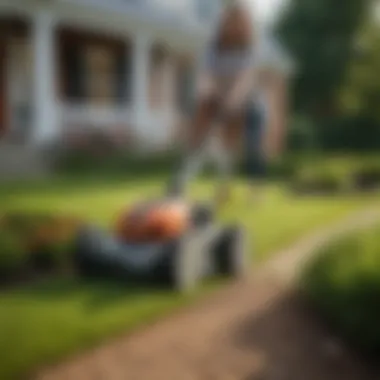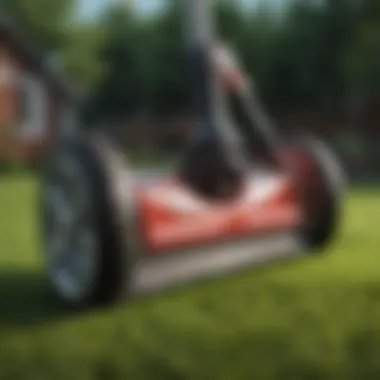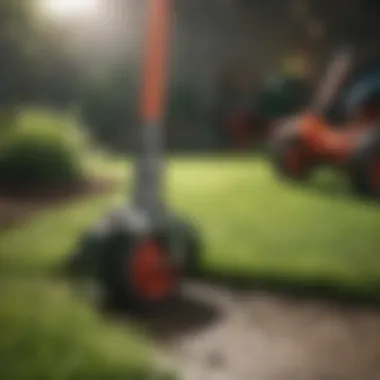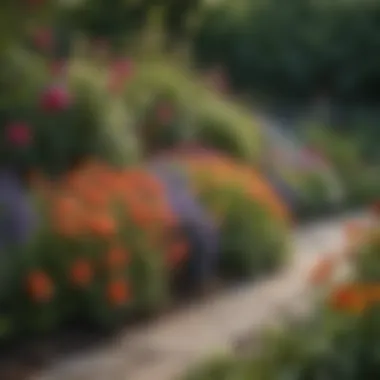A Comprehensive Guide to Garden Lawn Edgers


Intro
Maintaining a beautiful outdoor space is a priority for many homeowners. An often overlooked tool in achieving a polished garden aesthetic is the lawn edger. Lawn edgers play a vital role in defining borders, creating tidy lines, and enhancing the overall appearance of your garden. In this guide, we will explore the various types of lawn edgers, their applications, and the best practices for using them effectively.
Knowing how to select the right lawn edger can immensely improve your gardening experience. We will cover the criteria to consider when choosing one, maintenance routines to extend its lifespan, and tips to ensure optimal results. This information is tailored for gardening enthusiasts who want to elevate their outdoor spaces.
Design Inspirations
Trending Styles
When thinking about yard design, your choice in lawn edgers can reflect the overall style of your garden. There are several styles to consider:
- Traditional Edgers: Often made of concrete or stone, these edgers give a classic look. They define spaces sharply and work best in formal gardens.
- Steel Edgers: Ideal for contemporary designs, steel options are sleek and minimalist.
- Plastic Edgers: Lightweight and easy to handle, they come in various colors and designs. They are suitable for informal garden styles.
These styles influence not just the practicality of edging but also how the garden communicates its identity.
Color Palettes
Color can significantly affect your garden’s visual appeal. Choosing an edger that contrasts or complements the existing plants is essential. Here are a few options:
- Earth Tones: Browns and greens blend seamlessly into natural landscapes.
- Bright Colors: These can add a playful touch, especially in family gardens.
- Monochrome Schemes: A black steel edger can lend a sophisticated feel when placed against vibrant flowers.
The edger's color can enhance the garden's features while keeping functionality in mind.
Maintenance and Upkeep
Seasonal Maintenance Checklist
To keep your lawn edger functioning properly, a seasonal maintenance checklist is beneficial:
- Spring: Clean the blade to remove dirt and debris. Check for rust or wear.
- Summer: Inspect every month. Keep the pathways clear for smoother operation.
- Autumn: Sharpen blades before winter storage. Clean thoroughly.
- Winter: Store in a dry place to prevent moisture damage.
By adhering to this checklist, you ensure the longevity of your edger.
Cleaning and Organization Tips
Proper cleaning and organization maximize efficiency:
- Regular Wipe-Down: After each use, wipe blades with a rag to prevent buildup.
- Storage: Keep your edger hung or in a tool box to prevent unnecessary wear.
- Labels: If you have multiple tools, label them for easy access.
Following these simple tips can save time and improve the functionality of your garden tools.
"A well-maintained lawn edger serves as an investment in your garden’s future aesthetic."
Preamble to Garden Lawn Edgers
Garden lawn edgers play a vital role in cultivating a tidy and aesthetically pleasing landscape. These tools are designed to create defined edges between lawns and other garden elements such as flower beds, pathways, or driveways. The significance of maintaining clean borders goes beyond mere visual appeal; it contributes to the overall health and structure of your garden. By controlling grass growth and preventing encroachment into flower beds, edgers help to preserve the design and functionality of outdoor spaces.
In landscaping, precise lines and defined spaces are essential. Edging not only enhances the beauty of the garden but also simplifies maintenance tasks. For homeowners and gardening enthusiasts, understanding the nuances of garden lawn edgers can lead to improved efficiency and better results. Knowledge about the various types of edgers and their specific applications empowers users to make informed choices that best fit their gardening needs.
Definition and Purpose
A garden lawn edger, in its simplest form, is a tool used to create clean divisions in the garden. The primary purpose of an edger is to cut a trench or groove between different areas, effectively managing the transition between grass and non-grass surfaces. This allows for aesthetic clarity and minimizes the need for frequent trimming. Edgers can vary in type, power source, and intended use, making them adaptable to various gardening styles and preferences.


The purpose extends beyond functional use; they also serve to enhance the overall garden design. Well-defined edges prevent grass from spreading into areas where it is not wanted, ultimately preserving the integrity of the selected landscape features. This promotes better organization and a more deliberate approach to gardening.
Importance in Landscape Design
The act of edging is often overlooked but it holds a critical place in landscape design. A clean edge provides immediate visual impact, creating an organized appearance that can draw attention to specific areas of the garden. This clarity helps to highlight paths, beds, and plant arrangements, ultimately making the garden more inviting.
Furthermore, edgers can assist in managing soil health. They can help control the spread of invasive grass species that might otherwise compete with garden plants. When used properly, they can improve access to all garden areas, making maintenance tasks like weeding and mulching simpler and more efficient.
Effective edging techniques contribute not only to aesthetics but also to the long-term health of your garden's ecosystem.
Types of Garden Lawn Edgers
Understanding the different types of garden lawn edgers is crucial for homeowners and gardening enthusiasts. Each type provides unique benefits that cater to diverse yard conditions and personal preferences. Knowing these distinctions can help in effectively maintaining the borders of your garden, ensuring a clean and manicured look. Choosing the right edger affects not just aesthetics, but also the efficiency of the gardening process itself.
Manual Lawn Edgers
Manual lawn edgers are perhaps the simplest form of edging tools. They require no power source, making them environmentally friendly and easy to operate. Typically made of a sharp blade and a handle, they work by slicing through grass and soil, creating a neater edge. One significant advantage of manual edgers is their precision. They allow gardeners to have control over the depth and angle of the cut, leading to a more tailored appearance.
However, using a manual edger can be labor-intensive. They require physical effort, which might not be ideal for larger gardens or those with tough soil conditions. For small to medium-sized yards, they can be perfect, especially for those who appreciate a more hands-on gardening approach.
Electric Lawn Edgers
Electric lawn edgers provide a more efficient way to achieve a clean garden edge. These tools are powered by electricity, meaning they require either an extension cord or a charged battery. Their blades rotate at high speed, cutting through grass and soil with relative ease. The benefits of electric edgers include less physical effort and quicker completion of tasks. They are suitable for most garden sizes and are often lighter than gas-powered options.
Nonetheless, users must be mindful of the power source's restrictions. Corded models can limit movement, while battery-powered versions await the need for regular charging. Gardners should consider the layout of their yard and their access to electrical outlets when selecting an electric lawn edger.
Gas-Powered Lawn Edgers
Gas-powered lawn edgers are known for their power and efficiency, making them ideal for larger gardens or tougher conditions. These tools run on gasoline, providing greater mobility without being tethered to a cord. They can handle various landscaping challenges, from thick grass to hard soil, often making them preferable for professional landscapers or homeowners with significant yard maintenance needs.
Despite their advantages, gas-powered edgers come with disadvantages. They tend to be heavier and may be more challenging to maneuvre, particularly for those not used to power tools. Moreover, they can produce emissions and noise, which might not align with the preferences of eco-conscious gardeners.
Battery-Operated Lawn Edgers
Battery-operated lawn edgers represent a more modern solution, combining convenience with environmental considerations. These tools offer the freedom of movement akin to gas-powered models while avoiding the emissions produced by gas engines. They are relatively quiet, making them suitable for urban settings or neighborhoods where noise may be a concern.
However, the trade-off involves battery life. Users must monitor battery levels and keep spare batteries handy for extended work sessions, especially in larger yards. Battery-operated edgers also often compete with electric models regarding power output, so it is essential to choose one that meets specific edging needs.
By understanding these different types of garden lawn edgers, you can make a more informed decision that aligns with your gardening style and yard requirements. Each type caters to unique circumstances, enabling individuals to achieve manicured outdoor spaces tailored to their desires.
Selecting the Right Lawn Edger
Selecting the appropriate lawn edger is essential for achieving a well-defined landscape. The right choice affects not only the aesthetics of your garden but also the efficiency of your gardening tasks. Understanding the various factors that influence your selection can lead to better performance and satisfaction.
Evaluating Yard Size and Terrain
The size and layout of your yard play a crucial role in determining which lawn edger will be most effective. Large areas may necessitate a gas-powered or electric model for efficiency, while smaller spaces can benefit from a manual edger. Additionally, the terrain of your yard is important. Uneven, rocky, or compacted soil may require a more robust device that can handle various obstacles. Consider the following:
- Yard Size: Is your lawn expansive or small? This helps identify power needs.
- Terrain Type: Are there slopes, hard soil, or existing garden beds? Rough terrain may require enhanced cutting ability.
Taking the time to measure your yard and understand its specifics will guide you toward the right machine to keep your edges tidy and your garden looking sharp.
Assessing User Comfort and Ergonomics
User comfort and ergonomics are often overlooked but are key aspects of selecting a lawn edger. An uncomfortable tool can lead to fatigue and reduced productivity. When choosing your edger, pay attention to the following:


- Handle Design: Ergonomically designed handles reduce strain on the wrists and hands, leading to a more enjoyable experience.
- Weight of the Edger: Heavier models may require more strength and stamina. A lightweight option can make edging tasks easier.
- Adjustability Features: Some edgers come with adjustable handles which can make it easier to customize the fit for different users.
Finding a lawn edger that suits your physical needs will make gardening a more pleasant task and improve the quality of the work produced.
Comparing Cost and Value
When it comes to gardening tools, striking a balance between cost and value is vital. With numerous options on the market, consider these points:
- Initial Cost: Compare prices across brands like Black & Decker and Craftsman. Look for features relevant to your needs.
- Durability: An edger with a higher upfront cost may offer better materials and longevity, ultimately saving money in repairs or replacements.
- Warranty and Service: Consider products that offer solid warranty terms. This can impact long-term satisfaction.
- User Reviews: Research opinions from current users on platforms like Reddit or gardening forums to understand the real-world performance of various edgers.
Investing time in evaluation can ultimately lead to better financial and functional decisions.
Choosing the right lawn edger is not just about the tool but understanding your unique gardening needs and how each option meets those needs.
Best Practices for Using Lawn Edgers
Using lawn edgers is essential for achieving professional-looking edges in your garden. Proper techniques can make a significant difference in appearance and functionality. Adopting best practices ensures that your efforts yield the desired results while prolonging the life of the equipment. It also helps you comply with safety regulations, making your gardening experience more enjoyable.
Preparation of the Work Area
Preparing the work area is a key step before using any lawn edger. Begin by assessing the area to identify any obstacles such as rocks, branches, or garden decor. Removing these objects minimizes the risk of damage to both the edger and the surroundings. Clear pathways and ensure the soil is not overly wet. Wet soil can lead to clogging in the equipment, making it less effective. It is also good practice to mark your edges clearly, especially if you are working on a larger area. Using string or spray paint can help visualize the lines you aim to create.
Proper Cutting Techniques
Using the right cutting technique greatly influences the outcome of your edging work. Start with a steady, even pace; rushing can result in uneven edges. For best results, position the edger at a slight angle to help the blades slice through the soil and grass effectively. When edging along pathways or garden beds, keep the blades just outside the turf line to avoid damaging the root system. For electric and gas-powered edgers, allow the machine to do the work. Do not force the device into the ground, as this could lead to wear or breakage.
Proper cutting not only improves aesthetics but also promotes healthy grass growth.
Safety Precautions
Safety is paramount when using lawn edgers. Always wear protective gear, including safety goggles and gloves. The goggles help protect your eyes from flying debris, while gloves provide grip and reduce the risk of injuries. Make sure to read the manual that comes with your lawn edger to understand its specific safety guidelines. Avoid operating the edger in rainy conditions to enhance stability. Lastly, keep bystanders and pets away during operation; accidents can occur if someone or something is too close to the cutting area. Regularly check the equipment before use to ensure it is in good working order. These practices create a safer environment for everyone involved.
Maintaining Your Lawn Edger
Maintaining your lawn edger is crucial for ensuring its longevity and efficiency. An edger plays an essential role in achieving a neat, attractive garden. However, a neglected tool can lead to suboptimal performance and might even damage your landscape. Regular maintenance not only preserves the functionality of your equipment but also enhances the results you achieve in your gardening tasks. By understanding the various aspects of maintenance, you ensure a better cutting experience and prevent potential issues down the road.
Cleaning and Storage Practices
Keeping your lawn edger clean is fundamental. Dirt and debris can accumulate on blades and components, negatively affecting performance. After each use, remove any residues by wiping down surfaces with a damp cloth. Make sure to pay attention to the blade area, as this is where most debris collects. It is also wise to inspect for any persistent clogs that could hinder performance.
For storage, consider a dry, sheltered location. Protect your edger from extreme weather. If you use an electric or battery-operated model, store it indoors to avoid moisture damage. Utilize a designated rack or space that keeps the equipment upright and prevents any contact with the ground. This helps in prolonging its life and ensures it’s ready for the next cutting task.
Sharpening Blades and Components
Maintaining sharp blades is vital for achieving clean cuts. Over time, blades dull from regular use, leading to a jagged appearance in your garden edges. Dull blades can tear grass instead of cutting it cleanly, which can result in unnecessary stress on your lawn. To sharpen blades, follow these steps:
- Disconnect the power source: Always ensure the edger is turned off and unplugged before starting.
- Remove the blade: Safely detach the blade according to the manufacturer’s instructions.
- Use a sharpening tool: A file or sharpening stone can be used for this purpose. Ensure you follow the angle of the original edge to maintain cutting efficiency.
- Reattach and test: Once sharpened, reinstall the blade securely and conduct a test cut to ensure everything functions smoothly.
By keeping your blades sharp, you greatly improve the quality and effectiveness of your edger.
Regular Maintenance Routines
Establishing a routine for maintenance checks is essential for keeping your lawn edger in prime condition. Here are some recommended practices:
- Inspect belts and cables: Regularly check for fraying or damage, especially in gas-powered and electric models.
- Change or clean air filters: Dirty filters can affect performance, especially in gas-powered edgers.
- Check fuel levels and type: Always use the appropriate fuel as noted in your owner’s manual, and ensure you are using fresh gasoline.
- Tighten loose screws and bolts: Vibration during use can lead to screws loosening. Checking them periodically is a proactive measure.
- Lubricate moving parts: Applying lubrication to moving parts can help reduce wear and smooth operation.


Incorporating these maintenance routines will not only extend the life of your edger but will also ensure it operates at its best at every use. Keeping your tool in good shape translates into better garden aesthetics and efficiency with your gardening tasks.
Common Issues and Troubleshooting
The function of garden lawn edgers is not just to create clean lines, but to ensure the visual appeal and health of a garden. However, even the best tools may face challenges. This section focuses on common issues that may arise when using lawn edgers and ways to troubleshoot them effectively.
Understanding these problems can save time and effort, while maximizing the performance of your tool and enhancing your gardening experience.
Understanding Performance Problems
Performance problems with lawn edgers can manifest in several ways. Common signs include uneven cuts, difficulty in maneuvering, and unusual noises. These problems can be frustrating, but they often have straightforward solutions.
- Uneven Cuts: This may be due to dull blades or improper alignment. Dull edges require more force to cut, which can lead to uneven results. Regular sharpening is key.
- Difficulty Maneuvering: A lawn edger that feels heavy or difficult to control can stem from an ergonomic design issue or the weight of the tool. Checking user comfort and making necessary adjustments can alleviate this problem.
- Unusual Noises: If the edger produces grinding or rattling sounds, it may indicate a mechanical issue. Checking for loose parts or debris caught in the blades is essential.
"Regular maintenance and a quick troubleshooting check can prolong the life of your lawn edger and ensure it works effectively."
Addressing Mechanical Failures
Mechanical failures can halt your work and lead to more significant issues if not handled promptly. Recognizing the symptoms early can save the user from unnecessary expenses and delays.
- Engine Failure: For gas-powered and battery-operated models, engine failure often results from a lack of fuel or battery issues. Checking fluid levels or ensuring a charged battery is critical before troubleshooting further.
- Blade Disengagement: Blades that detach during operation is a severe safety concern. Regularly inspecting blade attachments and ensuring they are fitted correctly can prevent this mishap.
- Electrical Malfunctions: Electric edgers may experience wiring issues, which can cause intermittent operation. A visual inspection of the cord and connections might reveal frays or breaks needing repair.
Addressing these issues promptly not only improves the performance of the edger but also ensures a safer gardening experience.
Environmental Considerations
Understanding the environmental impact of garden lawn edgers is crucial in promoting sustainable gardening practices. Lawn edging goes beyond aesthetics; it plays a significant role in soil health and the overall well-being of the garden ecosystem. By examining the environmental considerations associated with lawn edgers, homeowners can make informed decisions that contribute to a healthier and more sustainable outdoor space.
Impact of Edging on Soil Health
Lawn edging can influence the quality of the soil in several ways. When used properly, it helps to define garden boundaries and reduces soil erosion. Erosion can lead to nutrient loss, which is detrimental for plants. Well-defined edges can retain moisture, keeping the soil more hydrated and reducing the need for excessive watering.
Additionally, proper edging allows for better aeration of the soil. This is essential for root growth and the overall health of plants. When the edges of the lawn are well-maintained, it often results in improved soil structure and fertility.
Edging may also create distinct habitats for beneficial organisms. For instance, insects like earthworms can thrive in well-maintained edges, aiding in the breakdown of organic matter and improving soil texture. It is important to avoid damaging these habitats when performing lawn maintenance, as they contribute to the ecosystem's balance.
Proper lawn edging not only enhances the visual appeal but also supports the ecological balance and soil health in your garden.
Choosing Eco-Friendly Options
With the push for sustainable practices, choosing eco-friendly lawn edgers is essential. Homeowners now have access to various sustainable products that reduce negative environmental impacts. Here are some considerations for selecting eco-friendly lawn edgers:
- Manual Lawn Edgers: Manual options do not require fuel or electricity, which means they are more environmentally friendly. They also offer precision without noise pollution.
- Electric Lawn Edgers: Electric models produce fewer emissions compared to gas-powered ones. When possible, choose corded models to eliminate battery waste.
- Battery-Operated Lawn Edgers: These are a middle ground, offering flexibility without direct emissions. Opt for rechargeable options to minimize waste.
- Material Choices: Look for lawn edgers made of recycled or sustainable materials. This choice reduces the carbon footprint associated with raw material extraction.
Incorporating eco-friendly lawn edgers into your gardening practices is a step toward protecting the environment. It is vital to consider not just the performance but the sustainability of the tools you use. By making conscious choices, gardeners can contribute positively to the ecosystem while maintaining beautiful outdoor spaces.
Finale
The conclusion serves as a reflection on the vital role garden lawn edgers play in landscaping and garden maintenance. Throughout this guide, we have explored various aspects of lawn edgers, from their types and benefits to best practices for usage. It is important to understand that a well-defined edge not only enhances the visual appeal of your garden but also contributes to the overall health of your landscape.
In summary, employing the correct lawn edger improves not just aesthetics but also leads to efficient garden maintenance. With the right tools and knowledge, homeowners can achieve crisp and clean edges that emphasize pathways, flower beds, and lawn borders. Therefore, choosing a suitable lawn edger that fits your specific needs, considering factors like yard size and terrain, is paramount.
Additionally, understanding effective maintenance routines allows for prolonged usage of the edger and optimal performance. Addressing common issues early will save time and resources, making your gardening tasks more enjoyable. Consequently, a proper understanding of these key elements not only beautifies your space but enhances your experience as a gardener.
Recap of Key Points
- Types of Lawn Edgers: Understand the distinctions between manual, electric, gas-powered, and battery-operated edgers. Each has unique advantages depending on yard size and user preferences.
- Selecting the Right Edger: Evaluate your specific landscaping needs, taking into consideration yard size, terrain, and your own ergonomics.
- Best Practices: Always prepare the work area effectively. Use proper cutting techniques to ensure safety and efficiency, while adhering to essential safety precautions.
- Maintenance: Regular cleaning, sharpening, and general upkeep of your edger are necessary to keep it functioning well and prolong its life.
- Troubleshooting: Familiarizing yourself with common issues can help eliminate downtime and ensure continuous performance.
- Environmental Impact: Understanding how edging can affect soil health and choosing eco-friendly options is crucial for sustainable gardening practices.
Encouragement for Continued Learning
Gardening is a continuous learning process. The information contained within this guide serves as a foundation, but there is always more to discover and explore about garden lawn edgers and overall landscaping practices. Consider engaging with community forums such as reddit.com or expert resources on sites like britannica.com and en.wikipedia.org for further insights.
The world of gardening is always evolving. Techniques improve, new products emerge, and sustainable practices develop. Engaging actively in this community can enhance your gardening efforts and knowledge. As you expand your understanding and refine your skills, the satisfaction derived from a beautifully maintained garden will undoubtedly grow.







